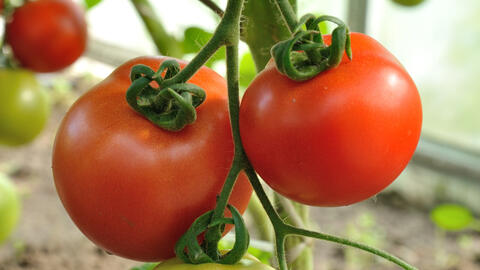Here’s how to plant tomatoes in a greenhouse
Tomatoes need warmth and are sensitive to rain - so they produce the greatest yields in greenhouses. We show you here how to lay the foundations for a good harvest when planting seedlings.

A film covering with good ventilation provides tomatoes with the perfect climate and is the best protection against the dreaded brown rot
What would the summer be without home-grown tomatoes? The number of delicious varieties is larger than for any other type of vegetable: red, yellow, striped, round or oval, cherry-sized or nearly weighing a pound. It’s best to choose a variety according to the intended purpose. Seedless, elongated Roma tomatoes are particularly delicious in pasta sauces, thick, fleshy tomatoes are used for grilling, plum-shaped mini tomatoes are best enjoyed as a snacking vegetable between meals. Tiny wild tomatoes are an eye-catcher on any vegetable platter, and yellow or orange-colored cocktail and cherry tomatoes look highly appetizing next to fresh, green herbs.
The earliest planting period in the greenhouse is mid-April. Loosen the earth as deeply as possible beforehand and then work in compost. Depending on pre-cultivation and soil condition, 0.53 to 0.79 gallons per 10.76 square feet is enough. Where fungal diseases are problematic, for example in regions with heavy new potato cultivation, follow up by pouring stinging nettle liquid manure or dusting rock flour and marine algae over the soil. A tomato house is recommended even in warmer locations. Even a simple, self-built film cover provides enough protection against the wind and rain, making the plants less susceptible to the dreaded brown rot.

There is no guarantee; in years with high infestation rates, an infection cannot be avoided even in a closed greenhouse. However, the disease generally progresses much more slowly in a greenhouse. An infection occurs if the leaves are dripping wet for more than several hours. First aid measures: Cut off and dispose of the lower leaves up to 15.79 inches above the soil. You can prevent any other diseases by regularly changing the plant bed. Although this is often not possible in smaller gardens or in the greenhouse. Tip: In this case, plant varieties such as ‘Hamlet’ or ‘Flavance’ that have the necessary resistance against soil fungus and root pests.
Stake tomatoes require a stable scaffold. Spiral metal rods at least 5.91 feet tall which plants can be easily guided up clockwise are particularly practical. On the other hand, cultivation on cords has proven itself successful in greenhouses or under film covers. These are simply secured to the roof struts and the stem base of the respective plant. Then simply wind the growing central shoot around the cord bit by bit.


Leave 23.62 to 27.56 inches in the row, and at least 31.5 inches space between rows. The ground should be loosened deeply and any weeds removed beforehand. Then simply rake in 1.32 gallons of mature compost per 10.76 square feet. You can dig out the first planting hole with a hand shovel. It should be about the depth of the pot ball plus 1.97 inches.


The tomatoes should be planted deeply enough that the lower 1.97 inches of the stem are covered with soil. This has two advantages: The plants will stand more securely and form additional roots above the ball.


The tomatoes need to be supported to prevent them from falling over under the weight of the tomatoes. Cultivation on a cord is a proven method under a film cover: Fix a sufficient length of new, plastic cord over each tomato plant to a strut of your film cover or greenhouse roof.









